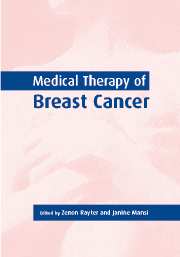Book contents
- Frontmatter
- Contents
- List of contributors
- 1 History of breast cancer therapy
- 2 Chemoprevention of breast cancer
- 3 Familial breast cancer
- 4 Hormone replacement therapy and breast cancer
- 5 Screening for breast cancer
- 6 The management of in situ breast cancer
- 7 Adjuvant systemic therapy
- 8 Adjuvant radiotherapy in the management of breast cancer
- 9 Predictors of response and resistance to medical therapy
- 10 Primary medical therapy in breast cancer
- 11 Medical therapy of advanced disease
- 12 Experimental approaches
- 13 The place of bisphosphonates in the management of breast cancer
- 14 Palliative care in breast cancer
- Index
10 - Primary medical therapy in breast cancer
Published online by Cambridge University Press: 06 January 2010
- Frontmatter
- Contents
- List of contributors
- 1 History of breast cancer therapy
- 2 Chemoprevention of breast cancer
- 3 Familial breast cancer
- 4 Hormone replacement therapy and breast cancer
- 5 Screening for breast cancer
- 6 The management of in situ breast cancer
- 7 Adjuvant systemic therapy
- 8 Adjuvant radiotherapy in the management of breast cancer
- 9 Predictors of response and resistance to medical therapy
- 10 Primary medical therapy in breast cancer
- 11 Medical therapy of advanced disease
- 12 Experimental approaches
- 13 The place of bisphosphonates in the management of breast cancer
- 14 Palliative care in breast cancer
- Index
Summary
Introduction
The definition of locally advanced breast cancer includes patients with large tumours, extensive regional lymph node involvement, or direct involvement of the skin or underlying chest wall. These tumours thus include stage IIIA and IIIB breast cancer as well as inflammatory breast cancer and involvement of the supraclavicular nodes (stage IV). Haagensen & Stout (1943) were the first to describe the clinical signs and then confirmed that these patients had a uniformly poor prognosis with no cures at 5 years in 120 patients treated with radical mastectomy (and 49% developing a local recurrence by 5 years) (Haagensen, 1971). Radiotherapy alone then became the standard treatment (Baclesse, 1949), with a local tumour control rate of 28% to 74% at 5 years and a 5-year survival of between 12% to 38% (Bouchard, 1965; Fletcher, 1972; Zucali et al., 1976; Langlands et al., 1976; Bruckman et al., 1979; Treurniet-Donker et al., 1980; Bedwinek et al., 1982; Balawajder et al., 1983). Some of these more recent studies compared radiation alone with a combination of surgery and radiotherapy and confirmed that the 5-year survival could be improved to between 35% and 55% (Fletcher, 1972; Zucali et al., 1976; Bruckman et al., 1979; Bedwinek et al., 1982; Balawajder et al., 1983).
Since the early 1980s there has been an increasing trend to offer systemic chemotherapy (so-called primary medical therapy or neoadjuvant therapy) as part of the multimodality approach. As a result of this it was found that a proportion of women could be offered conservative surgery and thus avoid a mastectomy.
- Type
- Chapter
- Information
- Medical Therapy of Breast Cancer , pp. 264 - 282Publisher: Cambridge University PressPrint publication year: 2003



